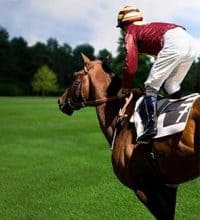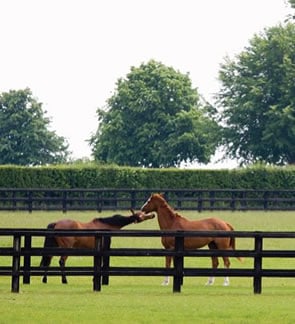Horse and Pony Paddock Grass Seed
Our Equine mixtures are of the highest quality and can be used for grazing, hay, gallops and top racecourses throughout the UK.
Horses and Ponies are choosy grazers. Offer them a paddock with a good grass cover and for no apparent reason they’ll still pick and choose between different areas. It’s therefore important to ensure paddocks are seeded with a full seeding rate which includes plenty of ‘bottom’ grasses to produce a dense sward capable of withstanding intense wear, high in fibre and most of all, low in sugar.
-
 SALEQuick ViewGALLOPS & RACECOURSES 60% Dwarf Perennial Ryegrass, Diploid, 20% Dwarf Perennial Ryegrass, Diploid, 20% Strong Creeping Red Fescue Exceptional Coastal or inland grass seed mixture ideal for for intense wear or “working the horse”. This specific mixture produces a dense, springy sward which enables frequent use of areas requiring rapid re-growth . This seed mixture is perfect for over-seeding early March – late November as a renovation mixture, Creeping Red Fescue Grass will help to improve the root strength and appearance of the turf. TOP PERFORMING FESCUE Provide a fantastic close knitted bottom sole to the sward, with great soil binding characteristics.
SALEQuick ViewGALLOPS & RACECOURSES 60% Dwarf Perennial Ryegrass, Diploid, 20% Dwarf Perennial Ryegrass, Diploid, 20% Strong Creeping Red Fescue Exceptional Coastal or inland grass seed mixture ideal for for intense wear or “working the horse”. This specific mixture produces a dense, springy sward which enables frequent use of areas requiring rapid re-growth . This seed mixture is perfect for over-seeding early March – late November as a renovation mixture, Creeping Red Fescue Grass will help to improve the root strength and appearance of the turf. TOP PERFORMING FESCUE Provide a fantastic close knitted bottom sole to the sward, with great soil binding characteristics. -
 SALEQuick ViewHORSE & PONY PADDOCK Long-Term Duration 15% Early Perennial ryegrass, Diploid, 15% Intermediate Perennial Ryegrass Diploid, 20% Late Perennial Ryegrass, Diploid, 15% Late Perennial Ryegrass, Tetraploid, 20% Strong Creeping Red Fescue, 15% Intermediate Timothy VERY FEW feed or seed companies now provide the expertise required to correctly formulate equine grass mixtures. More often than not a mixture best suited to silage for cattle is supplied. While what horse “folk” are looking for is a sward that is tidy, hardwearing and relatively easy to manage. What the horse is looking for is a short, dense sward that is palatable and will provide grazing for as many months of the years as possible. Horse Paddock Care – Laminitis Laminitis is one of the most common causes of lameness and disability of your best friend, Laminitis is a disease that affects the feet of hooved animals. It is characterized by inflammation of the digital laminae of the hoof. Severe cases with outwardly visibly clinical signs are known by the term founder. Greed or over feeding Theory states: if a horse is given excess grass it may be unable to digest all, causing fermentation in the hind gut and killing beneficial bacteria. This can result in body- wide inflammation, particularly in the laminae of the feet, where swelling tissues have no place to expand without causing injury to other structures.
SALEQuick ViewHORSE & PONY PADDOCK Long-Term Duration 15% Early Perennial ryegrass, Diploid, 15% Intermediate Perennial Ryegrass Diploid, 20% Late Perennial Ryegrass, Diploid, 15% Late Perennial Ryegrass, Tetraploid, 20% Strong Creeping Red Fescue, 15% Intermediate Timothy VERY FEW feed or seed companies now provide the expertise required to correctly formulate equine grass mixtures. More often than not a mixture best suited to silage for cattle is supplied. While what horse “folk” are looking for is a sward that is tidy, hardwearing and relatively easy to manage. What the horse is looking for is a short, dense sward that is palatable and will provide grazing for as many months of the years as possible. Horse Paddock Care – Laminitis Laminitis is one of the most common causes of lameness and disability of your best friend, Laminitis is a disease that affects the feet of hooved animals. It is characterized by inflammation of the digital laminae of the hoof. Severe cases with outwardly visibly clinical signs are known by the term founder. Greed or over feeding Theory states: if a horse is given excess grass it may be unable to digest all, causing fermentation in the hind gut and killing beneficial bacteria. This can result in body- wide inflammation, particularly in the laminae of the feet, where swelling tissues have no place to expand without causing injury to other structures.
VERY FEW feed or seed companies provide the expertise required to correctly formulate equine grass mixtures. More often than not a mixture of paddock grass seed best suited to silage for cattle or Sheep is supplied. What the horse is looking for is a short, dense sward that is palatable and will provide grazing for as many months of the years as possible.
Incorrect seeding
Horses are unable to fully digest excess grass, causing fermentation in the hind gut and killing beneficial bacteria. This can result in body- wide inflammation, particularly in the laminae of the feet, where swelling tissues have no place to expand without causing injury to other structures and a call to the Vet!
Horse Paddock Care – Laminitis
Laminitis is one of the most common causes of lameness and disability of your best friend, Laminitis is a disease that affects the feet of hooved animals. It is characterized by inflammation of the digital laminae of the hoof.
Horses have a sweet tooth
Just like humans! Having evolved as herbivores eating plant material, the horse’s sense of taste has developed to seek out carbohydrates. The downside is laminitis is linked to eating too much sugar.
Low Sugar (DNDF = Fibre grass)
The fibre content of grass is defined by the neutral detergent fibre content (NDF %). The NDF content of grazed grass varies from 35% for leafy fresh spring grass to 50% for stemmy grass. So, choosing the correct seed mixture which is low in sugars ensuring there is more than adequate fibre in your grazed grass.
Science makes your grass go further
Although overall grass quality is important, the nutritional quality of that grass can have a bigger effect on your horse or pony.


